Yellowstone National Park has the highest concentration of geothermal features of anywhere else on earth. The land literally smokes, bubbles and hisses. Numerous geysers erupt on a regular basis, including the most famous geyser in the world, Old Faithful. In this post, learn how to visit the geyser basins in Yellowstone National Park and which ones are worth your time.
About Yellowstone and Its Geysers
Most of Yellowstone sits atop a supervolcano. A supervolcano is a volcanic field that can produce a massive eruption. The Yellowstone supervolcano sits over a giant pool of magma which contains enough magma to fill the Grand Canyon 11 times.
This supervolcano powers the geothermal activity in the park, creating the geyser basins and bubbling mud pots that attract thousands of visitors every year.
The Yellowstone supervolcano last erupted 640,000 years ago and it is overdue for its next eruption. However, scientists have been monitoring the volcano and there are no signs of a future eruption.
Terminology
There are four geothermal features you will see in geyser basins in Yellowstone National Park: geysers, hot springs, fumaroles, and mud pots.
GEYSER: A geyser is a vent in the Earth’s surface that periodically ejects hot water and steam. Water on the surface of the earth seeps down into the earth. This water is heated by a magma chamber. The water is superheated and once it becomes hot enough, it is forcefully ejected out of the vent.
There are about 1000 geysers in the world and most of these can be seen in Yellowstone. The word “geyser” comes from the Icelandic name “Geysir,” the proper name of a hot spring in Iceland.
HOT SPRING: A hot spring, also called a thermal spring, is a spring with water temperatures that are much higher than the air temperature. Some, but not all hot springs are heated by magma below the Earth’s surface.
The colors in hot springs are caused by the bacteria and algae that live and thrive on these hot conditions.
FUMAROLE: A fumarole is a vent in the Earth’s surface that emits steam and volcanic gases.
MUD POT: A mud pot is an acidic spring with limited water. The mud bubbles, hisses, and belches hydrogen sulfide gas, with gives mud pots the odor of rotten eggs.
How to Use This Map: Click the icons on the map to get more information about each point of interest. To take this map with you, click the star next to the title of the map which adds it to your Google account. Next, within your Google Maps app, select ‘Saved’ and then select ‘Maps’. This map title will now appear in your list.
Upper Geyser Basin & Old Faithful
Within 1 square mile, there are over 150 geothermal features, making this one of best places in the park to see hot springs and geysers.
There are several sections of Upper Geyser Basin:
- Old Faithful
- Geyser Hill
- Along Firehole River
- Black Sand Basin
- Biscuit Basin

Old Faithful
Old Faithful is the world’s most famous geyser. For decades, this geyser has been erupting on a very reliable schedule. So reliable, in fact, that you can even get expected eruption times online to help you plan your visit.
Old Faithful Eruption Schedule: Old Faithful erupts roughly every hour and thirty minutes, give or take 10 minutes (although on rare occasions, it can take up to 2 hours for the next eruption). The eruption typically lasts 3 to 4 minutes. Get the next predicted eruption time here.
There are three ways to view the eruption of Old Faithful:
Grab a seat on the boardwalk that surrounds the geyser. This is the most popular and the most crowded viewpoint, since you can walk right up to the geyser to watch it erupt.

Hike to Observation Point on Geyser Hill for a bird’s eye view of Old Faithful. With just a handful of people, this is a great place to escape the crowds and still get a stunning view of the eruption. To get here, it is a 1.1-mile round trip hike. It’s a short, strenuous uphill walk to get the viewing area. We got here 30 minutes before the predicted eruption time and had a picnic lunch while waiting.

Take a seat at the viewing deck at the Old Faithful Inn. Get a drink at the bar, have a seat, and enjoy the view.
For full details on how to visit Old Faithful, with tips on how to avoid the crowds and how to plan your time, read our Guide to Old Faithful ↓
Yellowstone’s Old Faithful: 10 Tips to Have the Best Experience
Everything you need to know to visit Old Faithful and the nearby geyser basins.Geyser Hill
Geyser Hill is just a short walk from Old Faithful. Boardwalk trails weave their way between a handful of geysers, including Beehive Geyser and Giantess Geyser.
Beyond the boardwalk trail is a hiking trail that takes you farther up the hillside.
Observation Point sits at the top of this hill and it is our favorite viewpoint to watch an eruption of Old Faithful. It is 1.1 miles round trip to hike to Observation Point. To get up to Observation Point, you will hike up a series of switchbacks to get to the viewpoint.
Before you head back down towards Old Faithful, it is worth making the quick detour to Solitary Geyser. Most eruptions occur every 4 to 8 minutes and last 1 minute.

Along Firehole River
Stretching along the Firehole River, from Geyser Hill to Morning Glory Pool, is a boardwalk trail that passes by an incredible number of geysers and hot springs.
There are enough geysers in this short section that you will probably get to see at least one in action. The most notable geysers are:
- Grand Geyser: the tallest predictable geyser known
- Riverside Geyser: this geyser sits on the side of Firehole River and erupts into the river
- Grotto Geyser: this geyser erupts every 8 hours but once it gets going, the eruption can last anywhere from 10 minutes to several hours
- Castle Geyser: a cone geyser that erupts every 10 to 12 hours and lasts 20 minutes
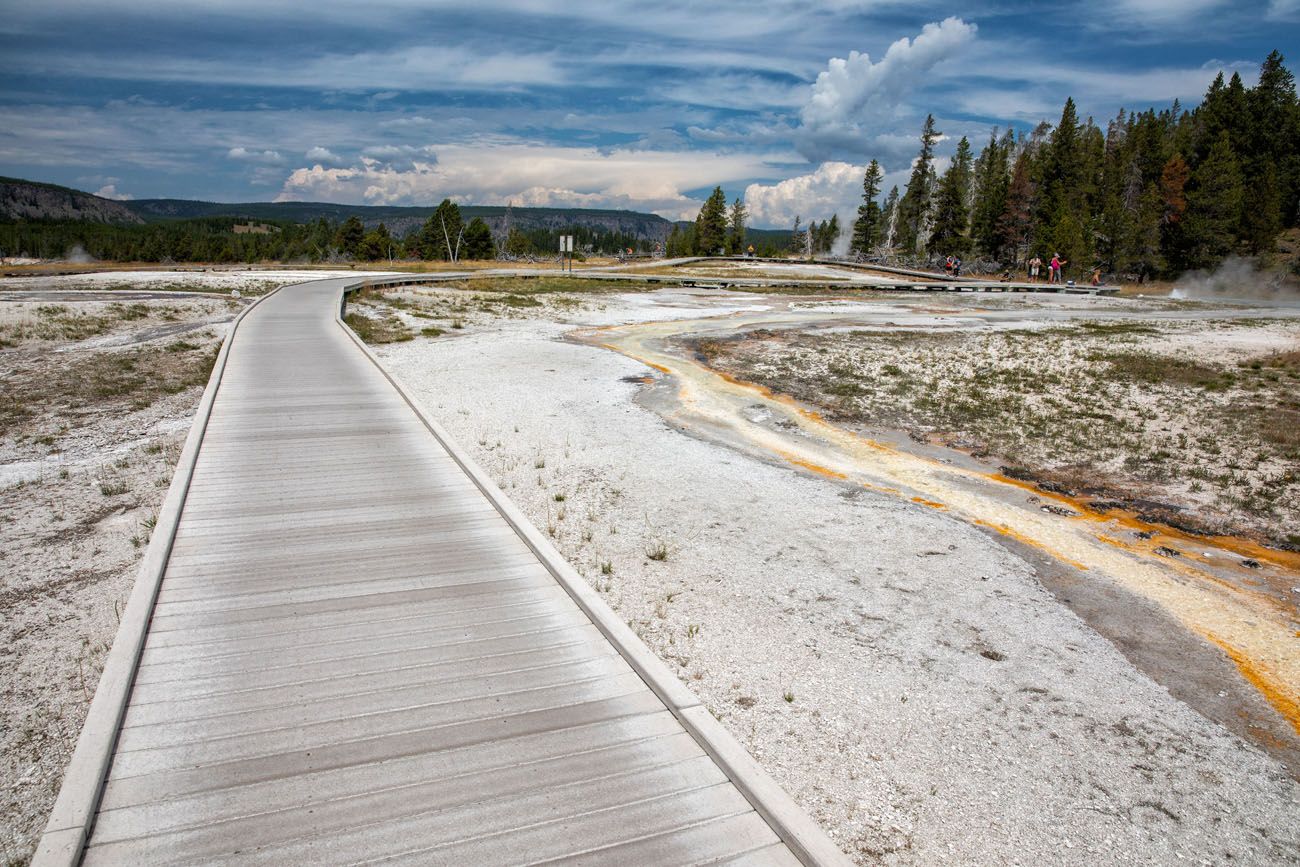
Boardwalk trail in Upper Geyser Basin

Spasmodic Geyser

Castle Geyser

Grotto Geyser
Morning Glory Pool sits at the north end of this section of geysers. This vibrantly colored pool is one of the prettiest features in Upper Geyser Basin and it is well worth the 3-mile round trip walk from Old Faithful.

Upper Geyser Basin Walking Route: Combine Old Faithful, Geyser Hill, and Firehole River into one easy-to-do walking loop. Watch the eruption from the boardwalk that surrounds Old Faithful. Walk the paved path out to Morning Glory Pool and then follow the boardwalk trails to Geyser Hill. From Geyser Hill, walk up to Solitary Geyser and Observation Point. If you get your timing right, you will be able to watch a second eruption of Old Faithful from here.
Black Sand Basin
This geyser basin is part of the Upper Geyser Basin. You can walk here from Old Faithful, but it’s a long walk, so I recommend driving here instead.
This geyser basin is named for its black sand, which is formed from obsidian, which occurs when lava cools very quickly. This is a showcase of colorful pools and Cliff Geyser, which erupts every few minutes.


Biscuit Basin
This geyser basin is also part of Upper Geyser Basin. Like Black Sand Basin, I recommend driving here, to save yourself a lot of time and energy, rather than walking.
The highlight here is Sapphire Pool, aptly named for its deep blue color.
Note: Biscuit Basin is closed in 2025 due to a hydrothermal explosion in 2024.

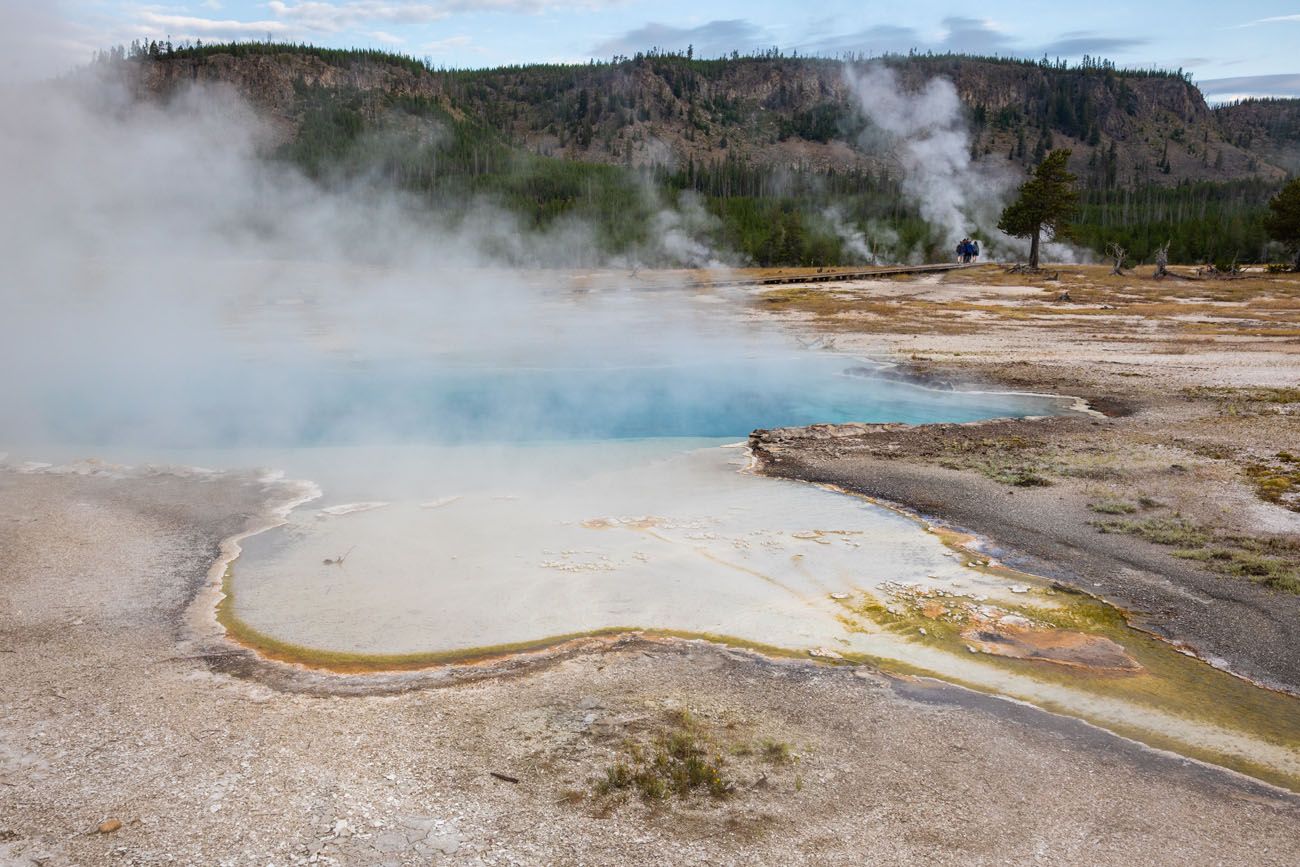
PRO TRAVEL TIP: During the morning hours, the hot springs can be covered in mist (our photo above was taken at about 8 am). It is impossible to capture the brilliant colors like you would see midday, but this can be a very quiet and peaceful time to visit these basins.
Midway Geyser Basin & Grand Prismatic Spring
There are two parts to a visit to Midway Geyser Basin: a walk along the boardwalk trail to get up close with Grand Prismatic Spring and the Grand Prismatic Spring Overlook.
Midway Geyser Basin Boardwalk
Midway Geyser Basin’s star attraction is the Grand Prismatic Spring.
Grand Prismatic Spring is the largest hot spring in the United States. The vibrant, rainbow of colors are a result of microbial life along the edges of the hot spring. The colors can change depending upon the presence of different microbes and the temperature of the water.
Grand Prismatic Spring may be the star of the show, but you can also see other brilliantly colored hot springs at Midway Geyser Basin: Excelsior Geyser Crater, Opal Pool, and Turquoise Pool.
A 0.8-mile boardwalk takes visitors past all of these hot springs. You will get up close to the Grand Prismatic Spring and the other hot springs. The boardwalk is one-way only.
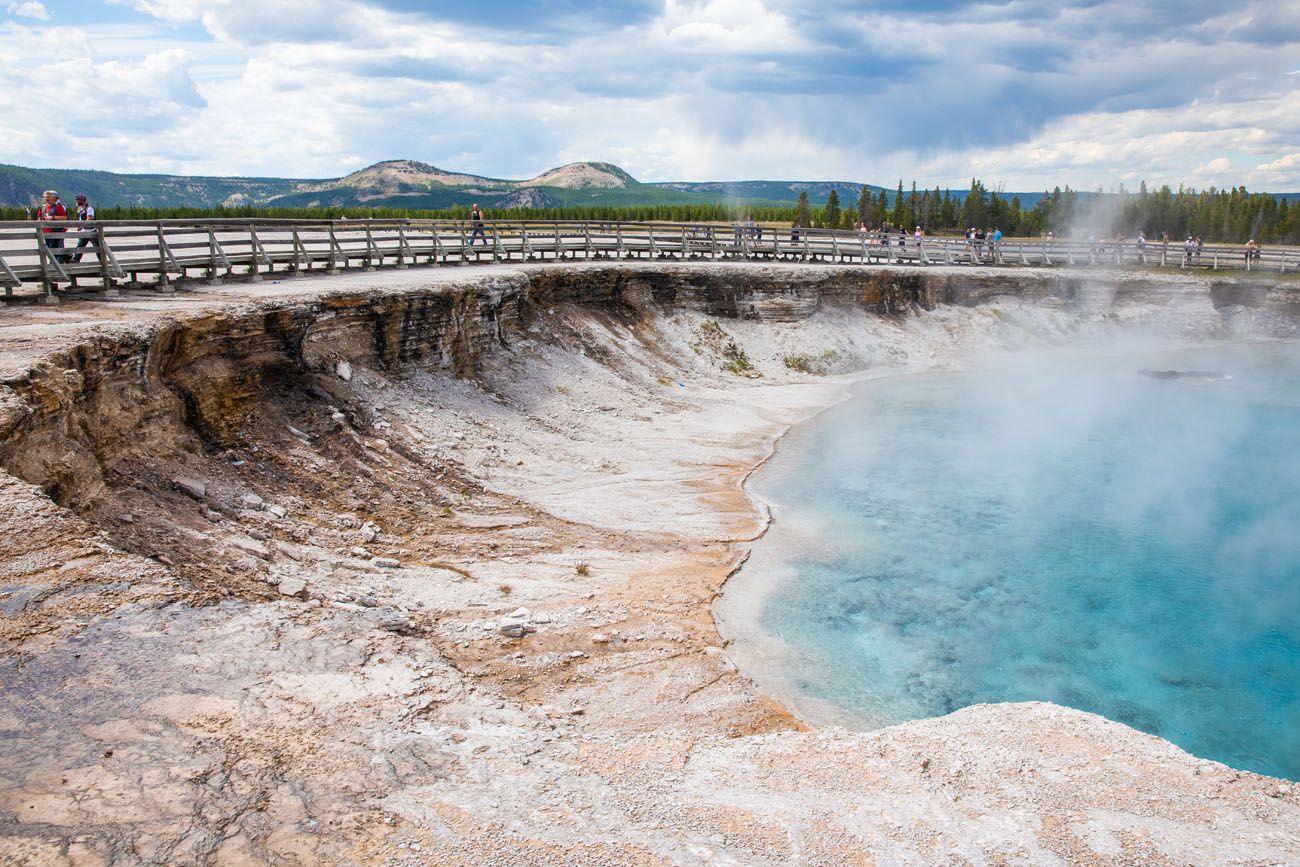
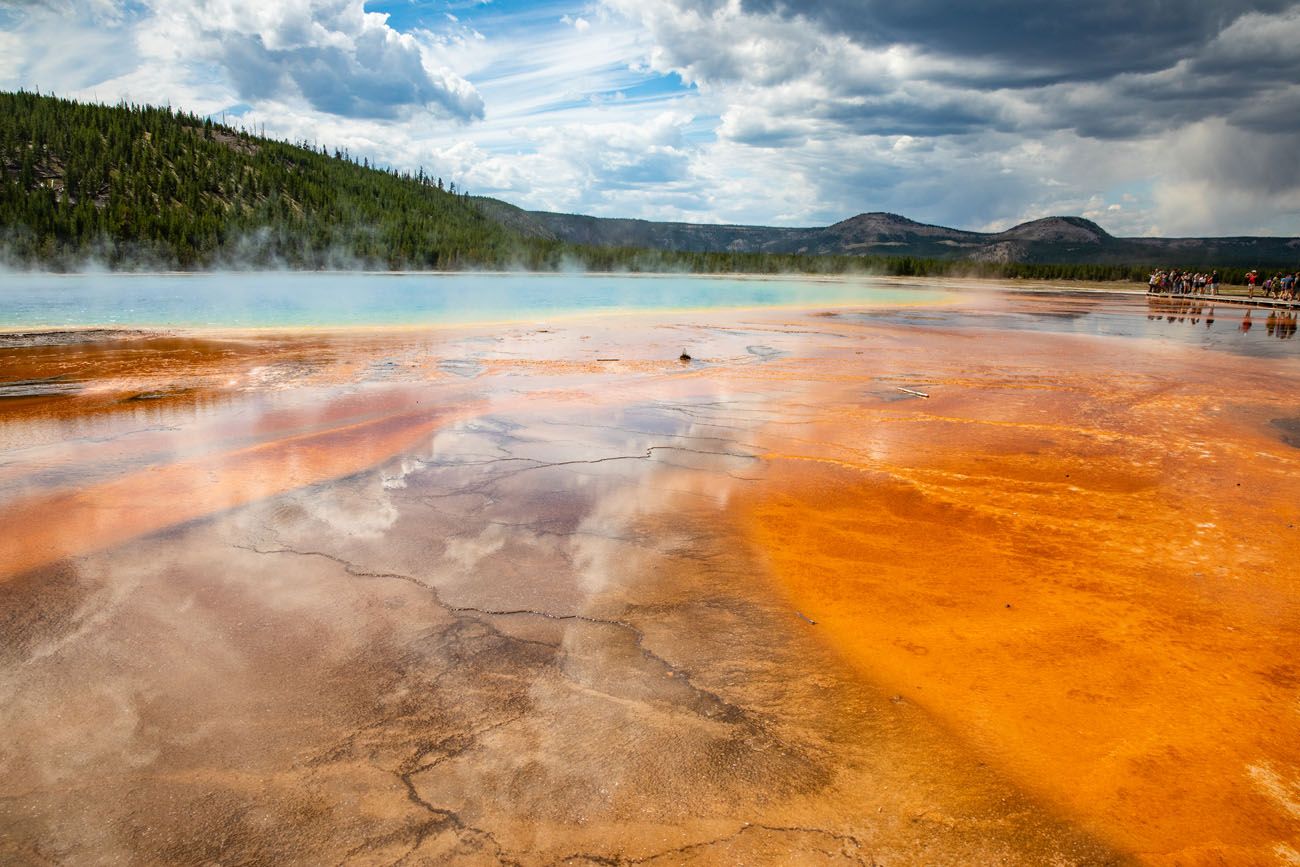
Parking at Midway Geyser Basin
The parking lot is ridiculously small for the number of visitors that the Grand Prismatic Spring gets. Most of the parking spills out onto the park road.
Normally, I would recommend waiting for a space in the parking lot, but if everyone did this, it would create stand-still traffic on the park road. There are large turn outs on the park road very close to Midway Geyser Basin. If the parking lot is full, park in one of these turn outs.
The busiest time to visit Midway Geyser Basin is from 9 am to 6 pm, which is essentially all day.
You can get here early to avoid the crowds, but the Grand Prismatic Spring is covered with mist in the morning, making it lackluster and it can be a disappointment. For the best experience, visit midday, once the mist burns off. Yes, it will be crowded, but it is worth it to see these colors.
PRO TRAVEL TIP:Parking at the most popular sites has become a big issue due to high crowds. There is just not enough parking for the number of visitors. You can get real time updates on parking availability and traffic conditions on the Yellowstone National Park website.
Grand Prismatic Spring Overlook
For a jaw-dropping view of the Grand Prismatic Spring, don’t miss the view from the overlook. On a sunny day, the colors are spectacular.

To see the spring from the overlook, you will have to drive and park at a different lot than the one for Midway Geyser Basin. It would be a very long walk (over two miles one way) to get from Midway Geyser Basin to the Grand Prismatic Spring overlook.
Park at the Fairy Falls parking lot. This is a large parking lot (much larger than the one for Midway Geyser Basin) but even so it can be difficult to get a spot midday.
Note: RV’s, buses, and cars pulling trailers are not permitted to park in this parking lot.
From the parking lot, it is a 0.8-mile walk to get to the overlook (1.6 miles round trip). Everything I read online lists this distance as 0.6 miles, but I walked the trail two days in a row with two different GPS devices and both gave the distance as 0.8 miles. It took us 15 minutes to walk here and we were walking fast, so I doubt that it is 0.6 miles.

It takes 15 to 20 minutes to walk to the Grand Prismatic Spring Overlook from the Fairy Falls parking lot, so plan on this visit lasting 45 minutes.
You also have the option to add on the short and relatively easy hike to Fairy Falls.
For more information on how to visit Grand Prismatic Spring and hike to Fairy Falls, read our guide to the Grand Prismatic Spring.
Lower Geyser Basin
Lower Geyser Basin contains about 100 geothermal features located across five square miles. This geyser basin sits to the north of Midway Geyser Basin.
You can see most of these geysers, hot springs, and fumaroles along Firehole Lake Drive, a one-way road that is just over 3 miles long.
Fountain Paint Pot Trail is a half-mile walk on a boardwalk that takes you past the four major hydrothermal features in Yellowstone: hot springs, geysers, mud pots, and fumaroles.
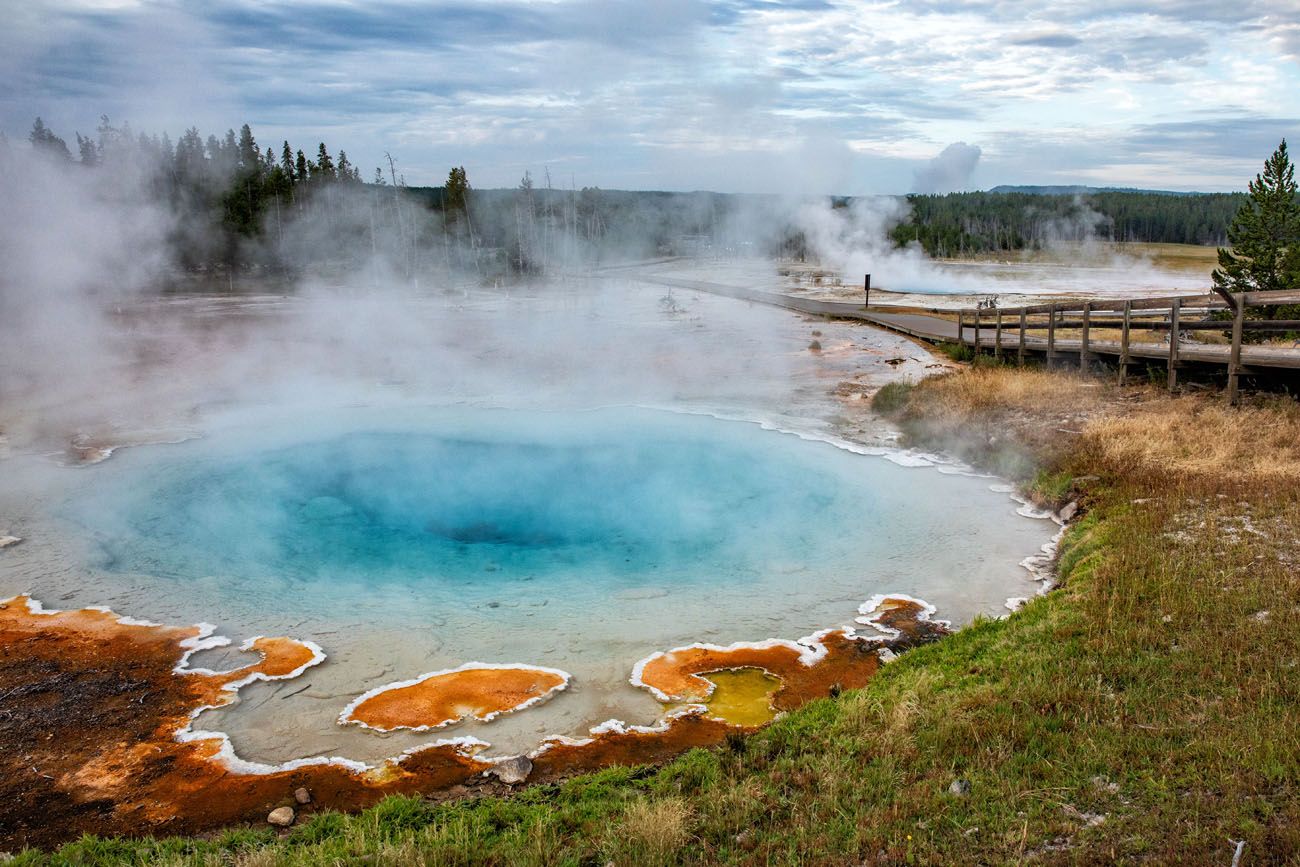

Mammoth Hot Springs
Mammoth Hot Springs is a large complex of hot springs that is located in north Yellowstone. Hot, steaming water spills out over travertine terraces, making this one of the most unique geothermal areas in the park.
These hot springs are spread over a large area. A visit here can be quick, with a short walk to one or two viewpoints. Or, you can spend an hour or two walking the boardwalk trails and going on the scenic drive.
The quickest way to get a look at these hot springs is to park along Grand Loop Road. There are several small parking lots here. Walk to the Lower Terraces to see the Liberty Cap and Devils Thumb.


Your visit can end here, but if you want to see more, follow the path uphill and walk the boardwalk trails around the higher level of terraces. The entire walk is 1 mile long and will take 30 to 40 minutes.

For the full experience, hop in your car and drive the one-way road through the Upper Terraces.
Norris Geyser Basin
Similar to the Upper Geyser Basin, this is another fairly large collection of geothermal features. It’s also one of the most rapidly changing basins in the park.
A visit here consists of seeing two basins: Back Basin and Porcelain Basin.
Back Basin
Back Basin is the larger basin.
It is here that you can see Steamboat Geyser, the world’s tallest active geyser. Major eruptions are very unpredictable but the geyser can spew hot, steaming water more than 300 feet in the air (for reference, Old Faithful eruptions are somewhere between 100 and 185 feet high).


There are numerous other hot springs and geysers in Back Basin, including Emerald Spring, Green Dragon Spring, Porkchop Geyser, and Puff ‘N Stuff Geyser (our favorite named geyser).
Porcelain Basin
Unless you catch Steamboat Geyser in action, Porcelain Basin is more thrilling. There is a lot of activity here. Steaming hot springs, light blue thermal pools, and noisy fumaroles really get your attention.



A visit to Norris Geyser Basin lasts 1.5 to 2 hours, if you visit both Back Basin and Porcelain Basin.
Artists Paintpots
Just south of Norris Geyser Basin is Artists Paintpots, a small area that contains several hot springs and mud pots. It feels like a long walk to get from the parking lot to the geyser basin (about a half-mile one-way) but it’s worth it. We loved the view from the upper boardwalk trail and the bubbling mud pots.


West Thumb Geyser Basin
West Thumb Geyser Basin is located right on Yellowstone Lake. This is a small geyser basin and it only takes about 30 minutes to walk through all of it. The highlight is Abyss Pool, a brilliantly blue hot spring, but it is also very cool to see geothermal activity right along the edge of the lake.



Mud Volcano
Mud Volcano is located near Hayden Valley. This is one of the best places watch, and listen to, bubbling mud.
A series of boardwalk trails climb up a hillside, past pots of bubbling mud and hot springs. This part of the park smells like rotten eggs, from the hydrogen sulfide gas that is emitted from these mud pots and hot springs.


Boiling River Hot Spring
Located between Mammoth Hot Springs and the Roosevelt Arch is a naturally occurring hot spring where you can go swimming. Not far from Mammoth, a hot spring enters the Gardner River. This natural hot tub is a popular swimming hole. Note: This has been closed since the flood in 2022.

Planning Your Visit
Do you need to visit all nine of these geyser basins and hot springs on a visit to Yellowstone? Of course not. They do get to be repetitive. Plus, there is so much more to do in Yellowstone…hiking trails to explore, scenic drives, wildlife encounters.
Here is a narrowed down list of the geyser basins in Yellowstone, ordered from must-see to might-be-worth-it.
Old Faithful: Watching an eruption of Old Faithful is one of the most popular and iconic National Park experiences in the United States. While you are here, spend another hour or two walking the boardwalk trails through Upper Geyser Basin.
Grand Prismatic Spring: Seeing the Grand Prismatic Spring from the overlook was one of our top experiences in Yellowstone National Park. In fact, we liked it so much that we did it twice. It’s much better to go midday on a sunny day, when you really get to see the vibrant colors. Just be prepared to brave the crowds. It’s also well worth it to walk the boardwalk trail at Midway Geyser Basin to get up close with the Grand Prismatic Spring.
Mammoth Hot Springs: These hot springs look very unique, with the steaming water spilling over the travertine terraces. With just 15 minutes, you can hop out of your car and see Liberty Cap. Or, spend several hours here, walking the boardwalk trail and driving the scenic loop.
West Thumb Geyser Basin: This is one of the smallest geyser basins but Kara and I really liked this one. It’s quick and easy to visit, the springs are a beautiful, brilliantly blue color, and you have wonderful views across Yellowstone Lake.

Yellowstone Lake seen from West Thumb Geyser Basin
Norris Geyser Basin: Norris Geyser Basin is large and it lacks a major attraction, such as Old Faithful at Upper Geyser Basin. However, if you get lucky enough to see Steamboat Geyser erupt, what an incredible experience that would be. Kara and I walked through Norris Geyser Basin first thing in the morning, when there were just a few people here. It was quiet and peaceful, except for the noisy fumaroles at Porcelain Basin.
Artist Paintpots: We loved the view from the upper boardwalk trail and the bubbling mud pots.
Here are three places you could skip, depending on your interests and how much time you have in Yellowstone.
Fountain Paint Pot Trail is part of the Lower Geyser Basin. It’s a quick, easy walk and you get to see all four of the geothermal features in Yellowstone. However, it looks very similar to the other geyser basins on this list, so you don’t miss anything by skipping it.
Boiling River Hot Spring is worth it if you want to relax in a hot spring. Otherwise, it’s not worth the walk just to see it. Just be aware that it has been closed since the 2022 flood. Get updates about its reopening on the National Park Service website.
Mud Volcano sounds interesting, with its pots of boiling mud, but Kara and I found this to be rather boring. You get to see mud pots in other geyser basins on this list, such as the Fountain Paint Pot Trail in Lower Geyser Basin.
If you have any questions about how to visit the geyser basins in Yellowstone, let us know in the comment section below.
More Information for Your Trip to Yellowstone




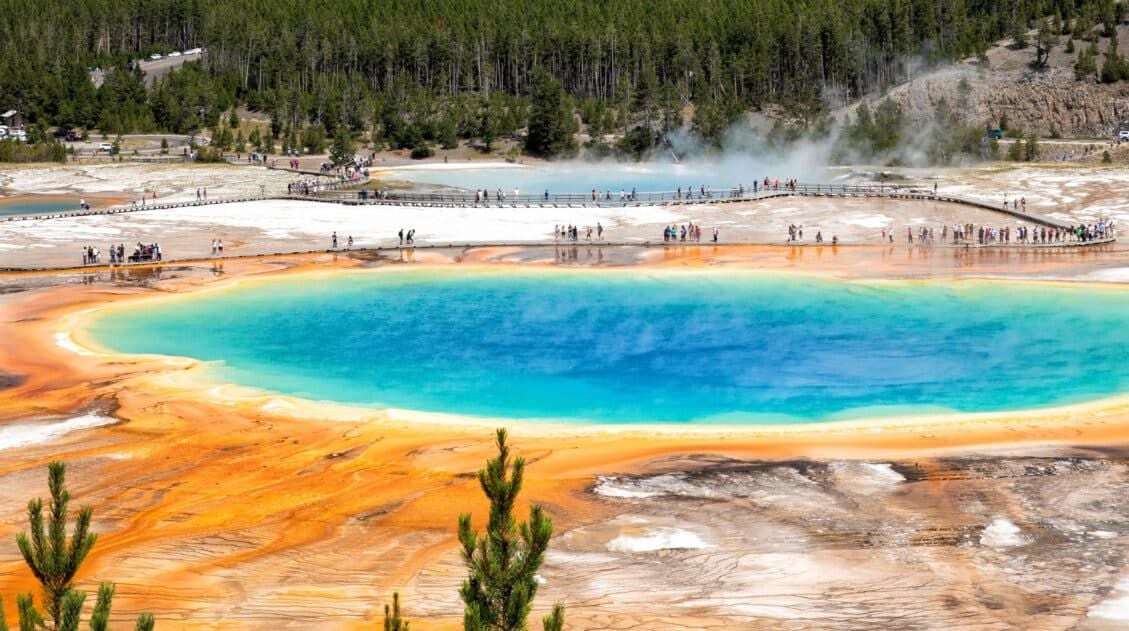




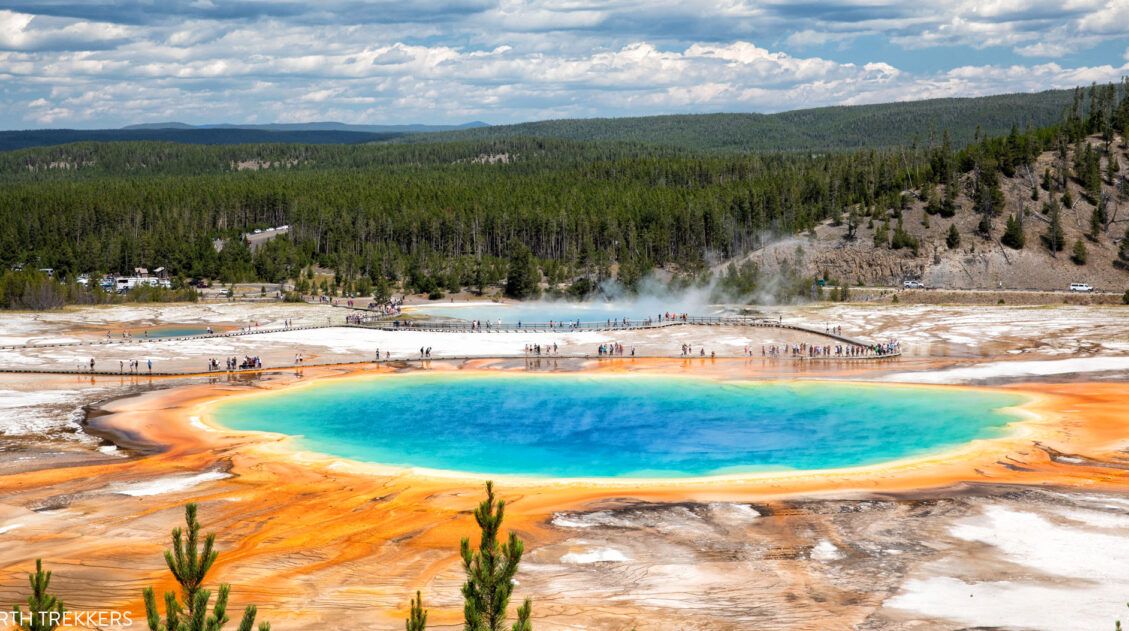




Comments 4